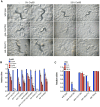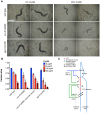Neuronal Goα and CAPS regulate behavioral and immune responses to bacterial pore-forming toxins
- PMID: 23349920
- PMCID: PMC3547950
- DOI: 10.1371/journal.pone.0054528
Neuronal Goα and CAPS regulate behavioral and immune responses to bacterial pore-forming toxins
Abstract
Pore-forming toxins (PFTs) are abundant bacterial virulence factors that attack host cell plasma membranes. Host defense mechanisms against PFTs described to date all function in the host tissue that is directly attacked by the PFT. Here we characterize a rapid and fully penetrant cessation of feeding of Caenorhabditis elegans in response to PFT attack. We demonstrate via analyses of C. elegans mutants that inhibition of feeding by PFT requires the neuronal G protein Goα subunit goa-1, and that maintenance of this response requires neuronally expressed calcium activator for protein secretion (CAPS) homolog unc-31. Independently from their role in feeding cessation, we find that goa-1 and unc-31 are additionally required for immune protection against PFTs. We thus demonstrate that the behavioral and immune responses to bacterial PFT attack involve the cross-talk between the nervous system and the cells directly under attack.
Conflict of interest statement
Figures




Similar articles
-
Global functional analyses of cellular responses to pore-forming toxins.PLoS Pathog. 2011 Mar;7(3):e1001314. doi: 10.1371/journal.ppat.1001314. Epub 2011 Mar 3. PLoS Pathog. 2011. PMID: 21408619 Free PMC article.
-
Hypoxia and the hypoxic response pathway protect against pore-forming toxins in C. elegans.PLoS Pathog. 2009 Dec;5(12):e1000689. doi: 10.1371/journal.ppat.1000689. Epub 2009 Dec 11. PLoS Pathog. 2009. PMID: 20011506 Free PMC article.
-
Activation of the unfolded protein response is required for defenses against bacterial pore-forming toxin in vivo.PLoS Pathog. 2008 Oct;4(10):e1000176. doi: 10.1371/journal.ppat.1000176. Epub 2008 Oct 10. PLoS Pathog. 2008. PMID: 18846208 Free PMC article.
-
Pore worms: using Caenorhabditis elegans to study how bacterial toxins interact with their target host.Int J Med Microbiol. 2004 Apr;293(7-8):599-607. doi: 10.1078/1438-4221-00303. Int J Med Microbiol. 2004. PMID: 15149037 Review.
-
Heterotrimeric G proteins in C. elegans.WormBook. 2006 Oct 13:1-25. doi: 10.1895/wormbook.1.75.1. WormBook. 2006. PMID: 18050432 Free PMC article. Review.
Cited by
-
Dysregulation of Neuronal Gαo Signaling by Graphene Oxide in Nematode Caenorhabditis elegans.Sci Rep. 2019 Apr 15;9(1):6026. doi: 10.1038/s41598-019-42603-1. Sci Rep. 2019. PMID: 30988375 Free PMC article.
-
Response Mechanisms of Invertebrates to Bacillus thuringiensis and Its Pesticidal Proteins.Microbiol Mol Biol Rev. 2021 Jan 27;85(1):e00007-20. doi: 10.1128/MMBR.00007-20. Print 2021 Feb 17. Microbiol Mol Biol Rev. 2021. PMID: 33504654 Free PMC article. Review.
-
Small RNA-mediated Cry toxin silencing allows Bacillus thuringiensis to evade Caenorhabditis elegans avoidance behavioral defenses.Nucleic Acids Res. 2018 Jan 9;46(1):159-173. doi: 10.1093/nar/gkx959. Nucleic Acids Res. 2018. PMID: 29069426 Free PMC article.
-
A sleep state during C. elegans development.Curr Opin Neurobiol. 2013 Oct;23(5):824-30. doi: 10.1016/j.conb.2013.02.015. Epub 2013 Apr 3. Curr Opin Neurobiol. 2013. PMID: 23562486 Free PMC article. Review.
-
Neural and genetic degeneracy underlies Caenorhabditis elegans feeding behavior.J Neurophysiol. 2014 Aug 15;112(4):951-61. doi: 10.1152/jn.00150.2014. Epub 2014 May 28. J Neurophysiol. 2014. PMID: 24872529 Free PMC article.
References
-
- Alouf JE (2003) Molecular features of the cytolytic pore-forming bacterial protein toxins. Folia Microbiol (Praha) 48: 5–16. - PubMed
-
- Derrick SC, Morris SL (2007) The ESAT6 protein of Mycobacterium tuberculosis induces apoptosis of macrophages by activating caspase expression. Cell Microbiol 9: 1547–1555. - PubMed
-
- Kobayashi SD, DeLeo FR (2009) An update on community-associated MRSA virulence. Current opinion in pharmacology 9: 545–551. - PubMed
-
- Van der Poll T, Opal SM (2009) Pathogenesis, treatment, and prevention of pneumococcal pneumonia. Lancet 374: 1543–1556. - PubMed
Publication types
MeSH terms
Substances
Grants and funding
LinkOut - more resources
Full Text Sources
Other Literature Sources
Miscellaneous

